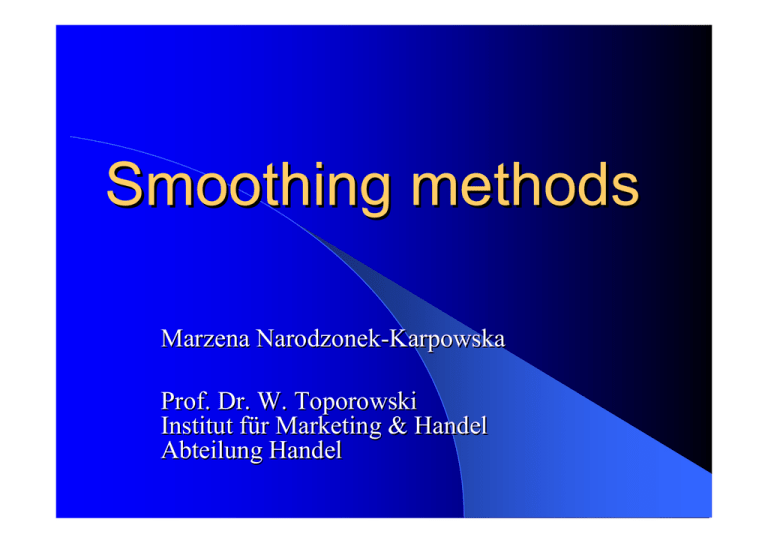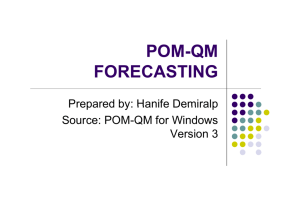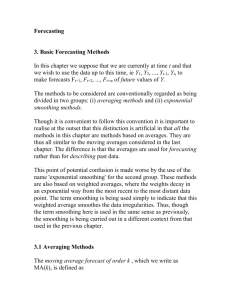Smoothing methods
advertisement

Smoothing methods Marzena Narodzonek-Karpowska Prof. Dr. W. Toporowski Institut für Marketing & Handel Abteilung Handel What Is Forecasting? z z Process of predicting a future event Underlying basis of all business decisions You’ll never get it right. But, you can always get it less wrong. Realities of Forecasting z z z Forecasts are seldom perfect Most forecasting methods assume that there is some underlying stability in the system and future will be like the past (causal factors will be the same). Accuracy decreases with length of forecast Forecasting Methods z z z z Qualitative Methods are subjective in nature since they rely on human judgment and opinion. Used when situation is vague & little data exist – New products – New technology Involve intuition, experience Quantitative Methods use mathematical or simulation models based on historical demand or relationships between variables. Used when situation is ‘stable’ & historical data exist – Existing products – Current technology Involve mathematical techniques Forecasting Methods Forecasting Methods Quantitative Causal Time Series Smoothing Trend Projection Qualitative Trend Projection Adjusted for Seasonal Influence What is a Time Series? By reviewing historical data over time, we can better understand the pattern of past behavior of a variable and better predict the future behavior. z z z Set of evenly spaced numerical data – Obtained by observing response variable at regular time periods Forecast based only on past values – Assumes that factors influencing past, present, & future will continue Example – Year: 2002 2003 2004 2005 2006 – Sales: 78.7 63.5 89.7 93.2 92.1 Time Series Forecasting Time Series Smoothing Methods Moving Average Linear No Yes Trend? Trend Models Exponential Smoothing Quadratic Exponential AutoRegressive Components of a Time Series z The pattern or behavior of the data in a time series has several components. Trend Cyclical Seasonal Irregular Trend Component z z The trend component accounts for the gradual shifting of the time series to relatively higher or lower values over a long period of time. Trend is usually the result of long-term factors such as changes in the population, demographics, technology, or consumer preferences Sales U nd e r t d r pwa Time Cyclical Component z z Any regular pattern of sequences of values above and below the trend line lasting more than one year can be attributed to the cyclical component. Usually, this component is due to multiyear cyclical movements in the economy. 1 Cycle Sales Year Seasonal Component z z z The seasonal component accounts for regular patterns of variability within certain time periods, such as a year. The variability does not always correspond with the seasons of the year (i.e. winter, spring, summer, fall). There can be, for example, within-week or within-day “seasonal” behavior. Sales Summer Winter Spring Time (Quarterly) Fall Irregular Component z z z The irregular component is caused by short-term, unanticipated and non-recurring factors that affect the values of the time series. This component is the residual, or “catch-all,” factor that accounts for unexpected data values. It is unpredictable. Components of Time Series Data Trend Cyclical Seasonal Irregular Components of Time Series Data Irregular fluctuations Cyclical Trend 1 2 3 4 5 6 7 Year 8 Seasonal 9 10 11 12 13 Smoothing Methods z z In cases in which the time series is fairly stable and has no significant trend, seasonal, or cyclical effects, one can use smoothing methods to average out the irregular component of the time series. Common smoothing methods are: Moving Averages Weighted Moving Averages Centered Moving Average Exponential Smoothing Moving Averages Method The moving averages method consists of computing an average of the most recent n data values for the series and using this average for forecasting the value of the time series for the next period. Moving averages are useful if one can assume item to be forecast will stay fairly steady over time. Series of arithmetic means - used only for smoothing, provides overall impression of data over time (most recent n data values) ∑ Moving Average = n Moving Averages Let us forecast sales for 2007 using a 3-period moving average. 2002 2003 2004 2005 2006 4 6 5 3 7 2007 ? Moving Averages Time 2002 1995 0032003 1996 2004 1997 2005 1998 2006 1999 2007 2000 Response Yi 4 6 5 3 7 NA Moving Total (n=3) NA NA NA 4+6+5=15 6+5+3=14 5+3+7=15 Moving Average (n=3) NA NA NA 15/3=5.0 14/3=4.7 15/3=5.0 Sales Moving Averages Graph 8 Actual 6 Forecast 4 2 95 96 97 Year 98 99 00 Moving Averages Graph Large n Actual Small n Demand Time Centered Moving Averages Method The centered moving average method consists of computing an average of n periods' data and associating it with the midpoint of the periods. For example, the average for periods 5, 6, and 7 is associated with period 6. This methodology is useful in the process of computing season indexes. 5 10 6 13 10+13+11: 3= 11.33 7 11 Weighted Moving Averages z z z Used when trend is present – Older data usually less important The more recent observations are typically given more weight than older observations Weights based on intuition – Often lay between 0 & 1, & sum to 1.0 WMA = Σ(Weight for period n) (Value in period n) ΣWeights 2x 12 Weighted Moving Average Graph Small weight on recent data Actual Large weight on recent data Demand Time Disadvantages of M.A. Methods z Increasing n makes forecast less sensitive to changes z Do not forecast trends well z Require sufficient historical data Responsiveness of M.A. Methods The problem with M.A. Methods : z z Forecast lags with increasing demand Forecast leads with decreasing demand Actual Demand, Moving Average, Weighted Moving Average 35 Sales Demand 30 Actual sales Weighted moving average 25 20 15 Moving average 10 5 D ec Ju l Au g Se p O ct No v Fe b M ar A pr M ay Ju n Ja n 0 Month All forecasting methods lag ahead of or behind actual demand M.A. versus Exponential Smoothing z Moving averages and weighted moving averages are effective in smoothing out sudden fluctuations in demand pattern in order to provide stable estimates. z Requires maintaining extensive records of past data. z Exponential smoothing requires little record keeping of past data. Form of weighted moving average – Weights decline exponentially – Most recent data weighted most Requires smoothing constant (α) – Ranges from 0 to 1 – Subjectively chosen z z Forecasting Using Smoothing Methods Exponential Smoothing Methods Single Exponential Smoothing Double (Holt’s) Exponential Smoothing Triple (Winter’s) Exponential Smoothing Exponential Smoothing Methods z z z Single Exponential Smoothing – Similar to single MA Double (Holt’s) Exponential Smoothing – Similar to double MA – Estimates trend Triple (Winter’s) Exponential Smoothing – Estimates trend and seasonality Exponential Smoothing Model z Single exponential smoothing model Ft +1 = Ft + α( y t − Ft ) or: or Ft +1 = αy t + (1 − α )Ft where: Ft+1= forecast value for period t + 1 yt = actual value for period t Ft = forecast value for period t α = alpha (smoothing constant) Single Exponential Smoothing z A weighted moving average z Weights decline exponentially, most recent observation weighted most The weighting factor is α – Subjectively chosen – Range from 0 to 1 – Smaller α gives more smoothing, larger α gives less smoothing The weight is: – Close to 0 for smoothing out unwanted cyclical and irregular components – Close to 1 for forecasting z z Responsiveness to Different Values of α 3000 2500 2000 1500 Actual demand alpha = 0.1 alpha = 0.5 alpha = 0.9 1000 1 2 3 4 5 6 7 8 9 10 11 12 Exponential Smoothing Example z Suppose we use weight α = 0.2 Quarter (t) 1 2 3 4 5 6 7 8 9 10 etc… Sales (yt) 23 40 25 27 32 48 33 37 37 50 etc… Forecast from prior period Forecast for next period (Ft+1) NA 23 26.4 26.12 26.296 27.437 31.549 31.840 32.872 33.697 etc… 23 (.2)(40)+(.8)(23)=26.4 (.2)(25)+(.8)(26.4)=26.12 (.2)(27)+(.8)(26.12)=26.296 (.2)(32)+(.8)(26.296)=27.437 (.2)(48)+(.8)(27.437)=31.549 (.2)(48)+(.8)(31.549)=31.840 (.2)(33)+(.8)(31.840)=32.872 (.2)(37)+(.8)(32.872)=33.697 (.2)(50)+(.8)(33.697)=36.958 etc… F1 = y1 since no prior informatio n exists Ft +1 = αy t + (1− α)Ft Sales vs. Smoothed Sales z Seasonal fluctuations have been smoothed 60 The smoothed value in this case is generally a little low, since the trend is upward sloping and the weighting factor is only 0.2 50 40 Sales z 30 20 10 0 1 2 3 4 5 6 Quarter Sales 7 8 Smoothed 9 10 Double Exponential Smoothing z Double exponential smoothing is sometimes called exponential smoothing with trend z If trend exists, single exponential smoothing may need adjustment z There is a need to add a second smoothing constant to account for trend Double Exponential Smoothing Model C t = α y t + (1 − α )( C t −1 + Tt −1 ) Tt = β(C t − C t −1 ) + (1 − β)Tt −1 Ft +1 = C t + Tt yt = actual value in time t α = constant-process smoothing constant β = trend-smoothing constant Ct = smoothed constant-process value for period t Tt = smoothed trend value for period t Ft+1= forecast value for period t + 1 t = current time period Double Exponential Smoothing zDouble exponential smoothing is generally done by computer zOne uses larger smoothing constants α and β when less smoothing is desired zOne uses smaller smoothing constants α and β when more smoothing is desired Exponential Smoothing Method You want to forecast sales for 2007 using exponential smoothing (α = 0.10). The 2001 forecast was 175. 2002 2003 2004 2005 2006 180 168 159 175 190 Exponential Smoothing Method Ft = Ft-1 + α (At-1 - Ft-1) Forecast, F t (α =0.10) Time Actual 2002 180 2003 168 175.00 + .10(180 - 175.00) = 175.50 2004 159 175.50 + .10(168 - 175.50) = 174.75 2005 175 174.75 + .10(159 - 174.75) = 173.18 2006 190 173.18 + .10(175 - 173.18) = 173.36 2007 NA 173.36 + .10(190 - 173.36) = 175.02 175.00 (Given) Exponential Smoothing Graph Sales Actual 190 180 170 Forecast 160 150 140 Year 02 03 04 05 06 07 Exponential Smoothing Graph Small α Actual Large α Demand Time Comparing Smoothing Techniques z Let us determine the smoothing technique that is best for forecasting these sales data : A two period moving average, a three period moving average, exponential smoothing (α=0.1), or exponential smoothing (α=0.2) Week Sales 1 110 2 115 3 125 4 120 5 125 Week 6 7 8 9 10 Sales 120 130 115 110 130 Measures of Forecast Accuracy Mean Squared Error (MSE) The average of the squared forecast errors for the historical data is calculated. The forecasting method or parameter(s) which minimize this mean squared error is then selected. Mean Absolute Deviation (MAD) The mean of the absolute values of all forecast errors is calculated, and the forecasting method or parameter(s) which minimize this measure is selected. The mean absolute deviation measure is less sensitive to individual large forecast errors than the mean squared error measure. You may choose either of the above criteria for evaluating the accuracy of a method (or parameter). 2 period moving average Sales Week (t ) Yt 1 2 3 4 5 6 7 8 9 10 11 110 115 125 120 125 120 130 115 110 130 n=2 Error Ft (Yt - Ft) (Yt - Ft) 2 #NV 112,5 120 122,5 122,5 122,5 125 122,5 112,5 120 12,5 0 2,5 -2,5 7,5 -10 -12,5 17,5 MSE 156,25 0 6,25 6,25 56,25 100 156,25 306,25 98,4375 3 period moving average Sales Week (t ) Yt 1 2 3 4 5 6 7 8 9 10 11 110 115 125 120 125 120 130 115 110 130 n=3 Error Ft (Yt - Ft) (Yt - Ft) 2 #NV #NV 116,6667 3,333333 11,11111 120 5 25 123,3333 -3,33333 11,11111 121,6667 8,333333 69,44444 125 -10 100 121,6667 -11,6667 136,1111 118,3333 11,66667 136,1111 118,3333 MSE 69,84127 Exponential smoothing (α=0.1) Sales Week (t ) Yt 1 2 3 4 5 6 7 8 9 10 11 110 115 125 120 125 120 130 115 110 130 α=0.1 Ft Error 2 (Yt - Ft) (Yt - Ft) #NV 110 5 25 110,5 14,5 210,25 111,95 8,05 64,8025 112,755 12,245 149,94 113,9795 6,0205 36,24642 114,5816 15,41845 237,7286 116,1234 -1,1234 1,262016 116,0111 -6,01106 36,13279 115,4099 14,59005 212,8696 MSE 108,248 Exponential smoothing (α=0.2) Sales Week (t ) Yt 1 2 3 4 5 6 7 8 9 10 11 110 115 125 120 125 120 130 115 110 130 α=0.2 Error Ft (Yt - Ft) (Yt - Ft) 2 #NV 110 5 111 14 113,8 6,2 115,04 9,96 117,032 2,968 117,6256 12,3744 120,1005 -5,10048 119,0804 -9,08038 117,2643 12,73569 MSE 25 196 38,44 99,2016 8,809024 153,1258 26,0149 82,45337 162,1979 87,91584 Comparing Smoothing Techniques z Since the three period moving average technique (MA3) provides to lowest MSE value, this is the best smoothing technique to use for forecasting these Sales data in our example. Thank You for Your Attention References z z z z z z z z z z z z z www.lsv.uni-saarland.de/Seminar/LMIR_WS0506/LM4IR_slides/ Alejandro_Figuera_Smoothing_Methods_for_LM_in_IR.ppt www.forecast.umkc.edu/ftppub/formula_pages/ch04lec.ppt www.angelfire.com/empire2/qnt531/workshop4.ppt www.swlearning.com/quant/asw/sbe_8e/powerpoint/ch18.ppt www.coursesite.cl.uh.edu/BPA/revere/DSCI5431/gradqntch_16&14.ppt www.cs.wright.edu/~rhill/EGR_702/Lecture%203.ppt www.lehigh.edu/~rhs2/ie409/BasicForecastingMethods.ppt www.cob.sjsu.edu/hibsho_a/ballou08aconcforecast.PPT www.mgtclass.mgt.unm.edu/MIDS/Kraye/Mgt%20300/Slide%20Show%2 0Week%20%232%20MGT%20300%20Forecasting.ppt www.infohost.nmt.edu/~toshi/EMGT%20501_files/Lectures/EMGT50113t hweek.ppt www.docp.wright.edu/bvi/classes/MBA780/MBA%20Forecasting-1.ppt www.cbtpdc.tamu-commerce.edu/gbus302/gbus302/ba578/Chapter14.ppt www.mgtclass.mgt.unm.edu/Weber/Mgt%20720/Unit%201/4.0_%20intro %20to%20forecasting.ppt








